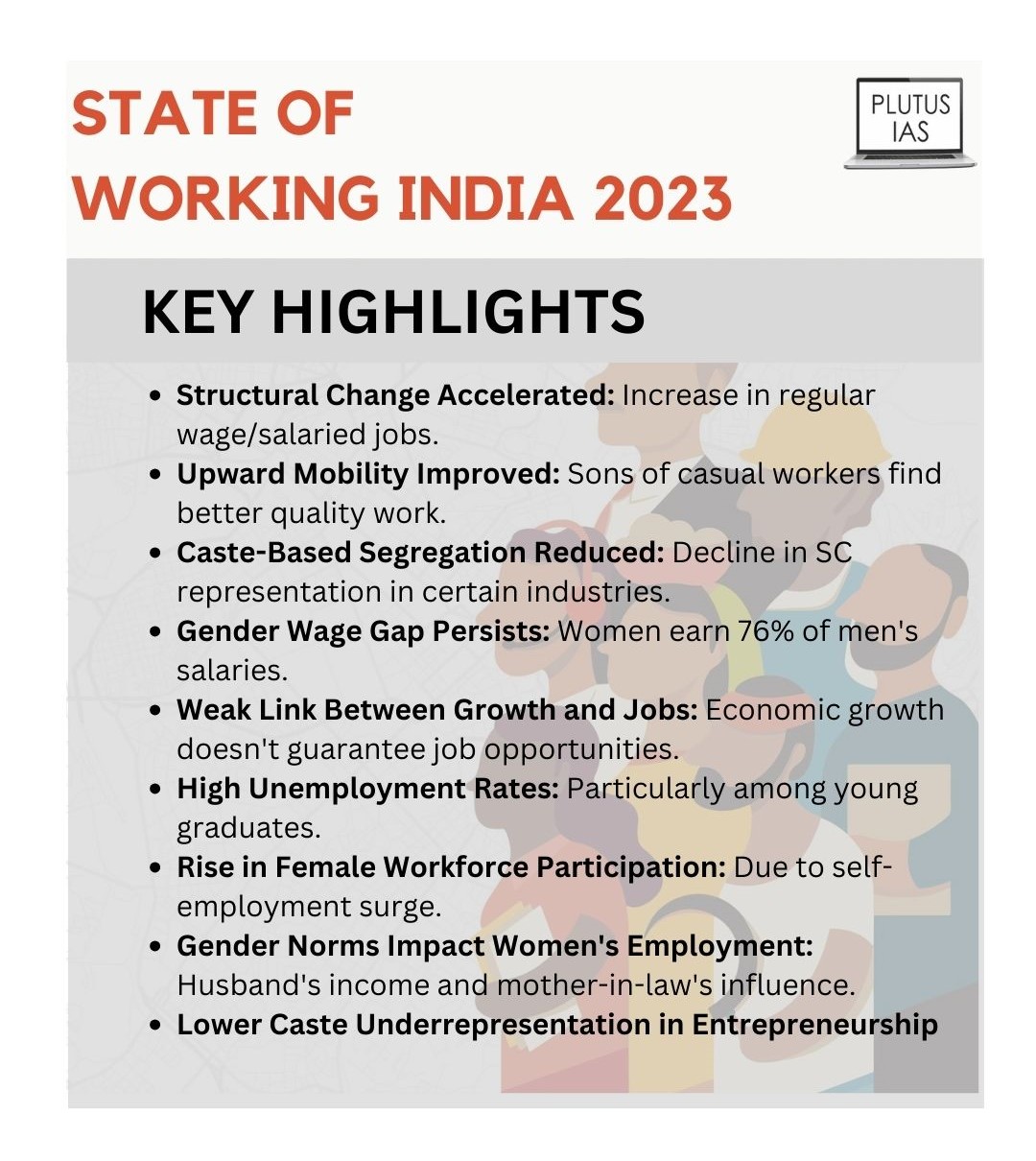25 Sep State of Working India 2023 Report
This article covers “Daily Current Affairs” and the topic details “State of Working India 2023 Report”. This topic has relevance in the “Economy” section of the UPSC CSE exam.
For Prelims:
Basic Concepts of Employment
For Mains:
GS3: Economy
Indian Economy and Issues Relating to Employment
Why in the news?
The Azim Premji University’s Centre for Sustainable Employment has released the ‘State of Working India 2023’ report.
About State of Working India 2023 Report
- The ‘State of Working India 2023’ report examines the effects of India’s economic slowdown from 2018 to 2020 and the subsequent impact of the Covid-19 pandemic on the labour market.
- The report relies on official datasets such as NSO’s Employment-Unemployment Surveys, Periodic Labour Force Surveys, National Family Health Surveys, Annual Survey of Industries, and Economic and Population Censuses to compile its findings.
- Additionally, it incorporates data from a unique primary survey conducted in rural Karnataka and Rajasthan, known as the India Working Survey.
- It employs regression analysis to provide precise estimates of how structural changes affect employment conditions and disparities.

Key Highlights from the Report:
- Faster Structural Change:
- Starting in 2004, there was a noticeable increase in the percentage of workers holding regular wage or salaried positions. This shift saw men go from 18% to 25% and women from 10% to 25%.
- However, since 2019, the creation of such jobs has slowed due to economic stagnation and the pandemic.
- Upward Mobility:
- In 2004, over 80% of the sons of casual wage workers found themselves in similar casual employment situations, irrespective of caste.
- By 2018, this figure had dropped significantly to 53% for non-SC/ST castes, coinciding with an increase in better-quality work like regular salaried positions.
- The decline was less pronounced for SC/ST castes.
- Reduced Caste-Based Segregation:
- In the early 1980s, Scheduled Caste (SC) workers were significantly overrepresented in waste-related and leather-related work, with over 5 and 4 times more representation, respectively.
- While this has decreased over time, some overrepresentation persists as of 2021-22, particularly in the leather industry.
- However, the representation index declined in the leather industry, reaching 1.4 in 2021.
- Gender-Based Earnings Disparities:
- In 2004, women in salaried positions earned 70% of what men earned. By 2017, this gender wage gap had reduced, with women earning 76% of men’s salaries. This disparity remained constant through 2021-22.
- Weak Link Between Growth and Quality Jobs:
- Since the 1990s, there has been no consistent correlation between year-on-year non-farm GDP growth and non-farm employment growth, suggesting that policies fostering economic growth may not necessarily lead to increased job opportunities.
- However, between 2004 and 2019, there was a positive relationship between growth and decent employment, which was disrupted by the pandemic.
- Unemployment Remains High:
- Despite a post-Covid decline, unemployment rates remain high, particularly for graduates, with a concerning 42% rate among graduates under 25 years old.
- Rising Female Workforce Participation:
- Since 2019, female employment rates have increased due to a distress-driven surge in self-employment.
- Before Covid, 50% of women were self-employed, which rose to 60% after the pandemic.
- However, this increase in self-employment did not lead to higher actual earnings. Even two years after the 2020 lockdown, self-employment earnings were only 85% of their pre-pandemic levels.
- Impact of Gender Norms:
- Gender norms significantly influence women’s employment. Women are less likely to work as a husband’s income increases, particularly in urban areas.
- However, in urban areas, once the husband’s income crosses ₹40,000 per month, the likelihood of the wife working increases again, creating a U-shaped relationship.
- The presence and employment status of mothers-in-law also have a strong impact on married women’s workforce participation.
- Lower Caste Entrepreneurship:
- Lower caste (SC and ST) entrepreneurs are underrepresented in businesses of all sizes.
- Even in the smallest firms, their representation is lower than their share in the overall workforce.
- This underrepresentation becomes more pronounced in larger firms, while upper castes become more overrepresented.
Basic Concepts:
- Labor Force:
-
- The Labor Force includes individuals who are either employed or actively seeking employment.
- It consists of both the employed and the unemployed individuals within a population who are of working age and are available and willing to work.
- Unemployment Rate (UR):
-
- The Unemployment Rate is the percentage of the labour force that is unemployed and actively seeking employment.
- Worker Population Ratio (WPR):
-
- The Workforce Participation Rate measures the proportion of a country’s population employed or actively seeking employment.
- Labor Force Participation Rate (LFPR):
-
- The Labor Force Participation Rate is the percentage of the population in the labour force.
Sources: ‘State of Working India’ in 7 charts: On women in workforce, educated youth unemployment and more
Download plutus ias current affairs eng med 25th Sep 2023
Q1. With reference to Employment, consider the following statements:
- The Labor Force includes exclusively employed individuals and not actively seeking employment.
- The Unemployment Rate (UR) is the percentage of the labour force that is unemployed and actively seeking employment.
- The Worker Population Ratio (WPR) measures the proportion of a country’s employed population.
Which of the statements given above is/are correct?
(a) 1 and 2 only
(b) 2 only
(c) 3 only
(d) None
Q2. Consider the following :
- The Centre for Sustainable Employment at the United Nations has published the ‘Status of Working India 2023’ report.
- According to the report, Women in India are less likely to work when their husband’s income rises, particularly in urban regions.
Which of the statements given above is/are correct?
(a) 1 only
(b) 2 only
(c) Both 1 and 2
(d) Neither 1 nor 2
Q3. Analyse the gender-based earnings disparities in India’s labour market. How has the gender wage gap evolved, and how does this disparity affect gender equality in the workforce?



No Comments